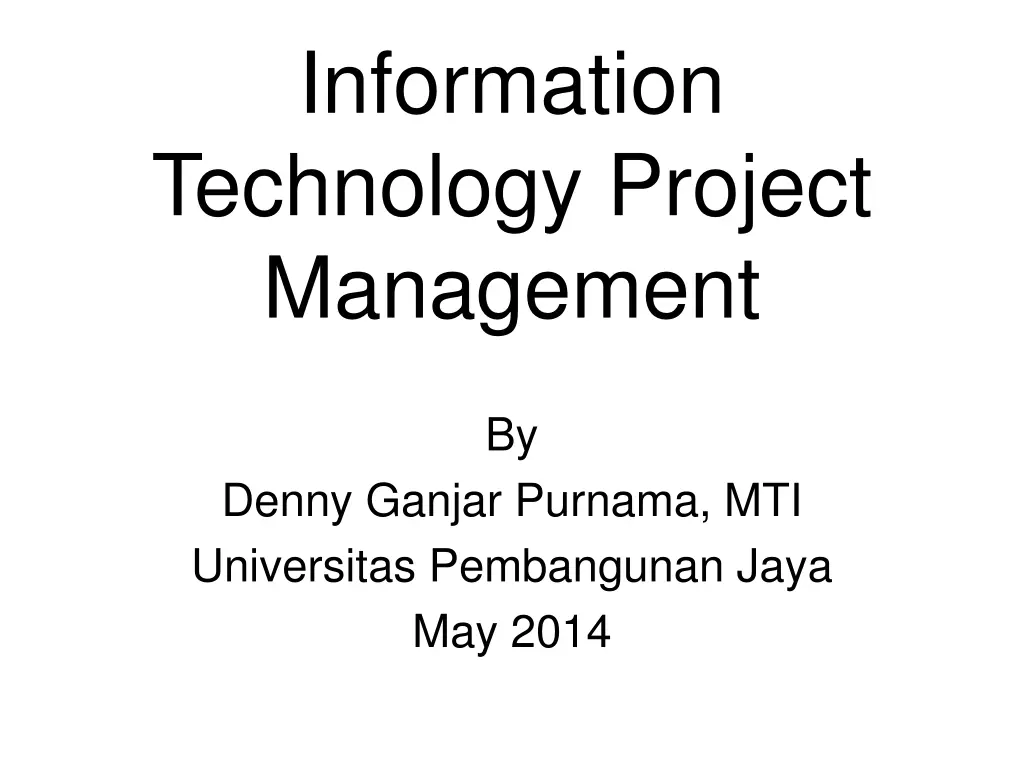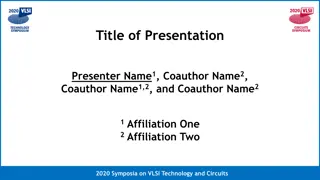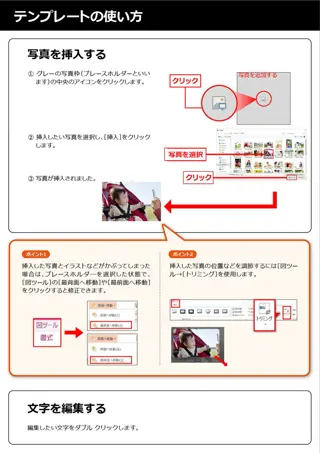
Understanding Project Procurement Management and Outsourcing in Information Technology
Explore the concepts of project procurement management and outsourcing in information technology projects, including definitions, reasons for outsourcing, advantages, disadvantages, and procurement processes. Learn about types of contracts, strategic approaches in outsourcing, and the evolution of the outsourcing phenomenon since 1989.
Download Presentation

Please find below an Image/Link to download the presentation.
The content on the website is provided AS IS for your information and personal use only. It may not be sold, licensed, or shared on other websites without obtaining consent from the author. If you encounter any issues during the download, it is possible that the publisher has removed the file from their server.
You are allowed to download the files provided on this website for personal or commercial use, subject to the condition that they are used lawfully. All files are the property of their respective owners.
The content on the website is provided AS IS for your information and personal use only. It may not be sold, licensed, or shared on other websites without obtaining consent from the author.
E N D
Presentation Transcript
Information Technology Project Management By Denny Ganjar Purnama, MTI Universitas Pembangunan Jaya May 2014
Chapter 12 Project Procurement Management and Outsourcing
Learning Objectives Define outsourcing, business process outsourcing, and offshoring. Describe the reasons why organizations outsource projects and project components. Describe the advantages and disadvantages of outsourcing. Describe several ways to improve the likelihood of outsourcing success.
Project Procurement Management Contract management and change control processes required to administer contracts or purchase orders issued by authorized project team members.
Project Procurement Process Plan puchase and acquisition Plan contracting Request seller responses Select sellers Contract administration Contract closure
Procurement Type of Contract 1. Fixed price or lump-sum Total / fixed price is negotiated as the final price for specific product/service 2. Cost-reimburse Reimburse to cover seller s actual cost Co: Cost plus fee, cost plus fixed fee, cost plus incentive fee 3. Time & Material contract Hybrid of those two
Outsourcing Is the procurement of products or services from an external vendor, supplier, or manufacturer In this respect, outsourcing is similar to project procurement management However, outsourcing provides more of a strategic approach, while project procurement management is more tactical
The Outsourcing Phenomenon Really started in 1989 when Eastman Kodak Company in Rochester, NY signed a 10-year, $250 million deal to outsource its entire IT function to IBM Within 1 year, Kodak s costs decreased almost 95%, PC support costs dropped to about 5-10%, while mainframe costs also were reduced by 10-15% Kodak was not the first or the largest company to turn to outsourcing, but it was the first well-known and successful company to outsource an entire IT function Subsequently, other companies began questioning whether they had to provide their own IT services and began talking about core competencies, cost savings, and strategic partnerships with IT vendors By the year 2000, IT came to a crossroads when more than 54% of IT services purchased in North America were outsourced Momentum is expected to continue in the U.S. and Europe
Types of Outsourcing Relationships Business Process Outsourcing Where an organization turns over processes other than just IT E.g., Accounting, Human Resources, R&D, etc. Offshoring Outsourcing to another country usually overseas in order to take advantage of labor arbitrage (cheaper labor)
Approaches to Outsourcing Just as an organization can pursue outsourcing as a strategic approach, so too can a project manager and team in terms of Full-Insourcing The organization or project develops all products and services internally Full-Outsourcing All products and services are acquired from external sources Selective Outsourcing Perhaps the best approach because it provides greater flexibility in choosing which processes or deliverables should be outsourced and which should be kept internal
Outsourcing Model The project team is responsible for all project processes & delivery of the project s scope All of the project processes & delivery of the project s scope is the responsibility of external sources Full Selective Outsourcing Full In-sourcing Outsourcing Provides the most flexibility because some project processes and scope are done internally by the project team, while others are outsourced externally. Figure 12.1
Realities of Outsourcing Before the Kodak deal, outsourcing was not a controversial topic, especially by IT professionals Controversy centers on offshoring, or the perception that jobs within one country are replaced by lower-wage jobs in another Many believe that domestic unemployment increases and negatively impacts the economy
Realities of Outsourcing Others believe that although some people lose their jobs because of outsourcing, many new, higher paying jobs are often created Organizational change management plays an important role in successful outsourcing relationships However, according to Peter F. Drucker (2002), if developing people is the most important task in business, then the trend towards outsourcing can reduce an organization s ability to gain competitive advantage in a knowledge economy
Managing the Outsourcing Relationship A study by Deloitte Consulting reports that 70% of 25 large organizations that took part in a survey reported negative experiences with outsourced projects and that a number of these companies are starting to bring projects back in- house Outsourcing is itself a project so following a project management approach makes sense for improving the likelihood of success
7 Deadly Sins of Outsourcing Activities and Projects 1. Outsourcing activities that should not be outsourced 2. Selecting the wrong vendor 3. Writing a poor contract 4. Overlooking personnel issues 5. Losing control over the outsourced activity 6. Overlooking the hidden costs of outsourcing 7. Failing to plan an exit strategy






















